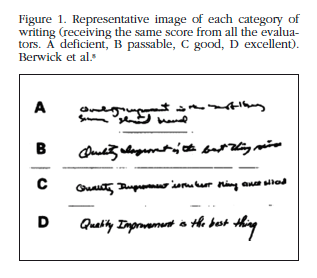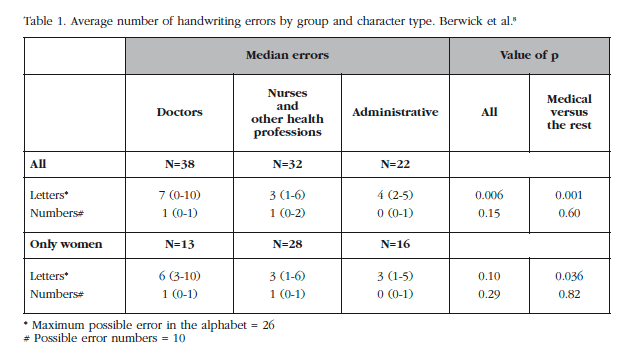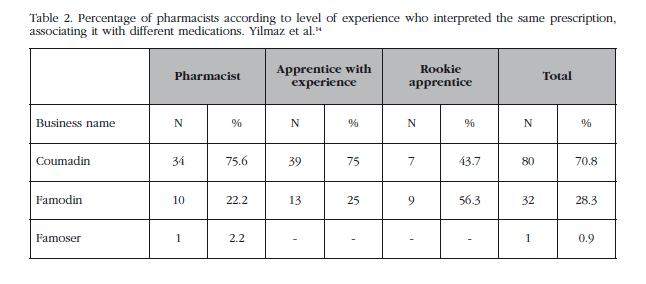Mi SciELO
Servicios Personalizados
Revista
Articulo
Indicadores
-
 Citado por SciELO
Citado por SciELO -
 Accesos
Accesos
Links relacionados
-
 Citado por Google
Citado por Google -
 Similares en
SciELO
Similares en
SciELO -
 Similares en Google
Similares en Google
Compartir
Revista de Osteoporosis y Metabolismo Mineral
versión On-line ISSN 2173-2345versión impresa ISSN 1889-836X
Rev Osteoporos Metab Miner vol.6 no.4 Madrid nov./dic. 2014
https://dx.doi.org/10.4321/S1889-836X2014000400008
Doctors handwriting
La letra de médico
Robaina Bordón J.M.1, Morales Castellano E.1, López Rodríguez J.F.1 and Sosa Henríquez M.1,2
1 Universidad de Las Palmas de Gran Canaria - Grupo de Investigación en Osteoporosis y Metabolismo Mineral - Las Palmas de Gran Canaria
2 Hospital Universitario Insular - Servicio de Medicina Interna - Unidad Metabólica Ósea - Las Palmas de Gran Canaria
Introduction
Doctors are famous for their poor handwriting. It is not for nothing that the expression "doctor's handwriting” exists, referring to handwriting which is almost illegible, and which, in all cases, only the art and sagacity of the pharmacist can decipher. In fact, if one looks for the definition of "legibility” in some online dictionaries phrases such as: "the legibility of this prescription is nil” are given as an examples1. Popular culture considers this fact as an almost inherent quality of the medical profession.
However, from a legislative point of view, Royal Decree 1718/2010 of 17th December, regarding medical prescriptions and dispensary orders, states: "All the data and instructions given on medical prescriptions should be clearly legible"2. Doctors therefore have a duty to write their prescriptions clearly.
Is there any truth to all this? It may be that doctors' handwriting is as legible as that of the rest of the population and that what we have here is an urban legend. Or if it is indeed the case that doctors have worse, often illegible writing, what impact could this fact have on the health of their patients? These questions have led us to investigate what has been published about this matter in the scientific literature, with the aim of finding firm answers.
Materials and methods
In order to research this article we carried out a bibliographic search in the following databases:
a) In Spanish: Google Academic, SciELO, Dialnet, Freemedicaljournals and Latindex, using different combinations with the following key words: letra, médico, legible, ilegible, legibilidad, prescripción, doctor,
b) In English: PuMed, Google Scholar, DOAJ, Freemedicaljournals, Open J-Gate, Electronic Journals Library, EBSCO, EMCARE and Academic Keys. The terms used were: Writing, medical, illegible, legibility, prescription, doctor.
Results
History
There have been references to the handwriting of doctors since the time of Molière. Hence, in his play "The Doctor in Spite of Himself" (in Spanish, "El médico a palos") the author satirised doctors who wrote in a Latin which was illegible to all but themselves3. A century ago, in The Lancet, in January 1915, an editorial condemned poor handwriting, reproducing "the most atrociously illegible prescription ever seen", as well as the arbitrary way in which it was interpreted by the pharmacist. They concluded that "unless there may be an understanding or private code between the prescriber and the pharmacist, the only thing that could be said of this prescription is that the doctor wrote it should have been ashamed of themselves"4. Forty years later, the topic appears again in a letter from J.J. Conybeare, who comes to the defence of bad handwriting, saying that he considered it to be a mistake to penalise an examinee for poor handwriting, maintaining that "trying to decipher handwriting was a question of honour, and that deliberate penalisation should be avoided"5. A debate then ensued between defenders and detractors of the illegibility of doctors' handwriting. Hence, a month later, a letter from W.W Kaye supported the opposite position, expressing the view that it was not enough to penalise exams or written tests by reducing marks for poor handwriting, but even proposing that disapproval should be shown. He considered that "poor handwriting could only be considered to be no less an example of bad manners than presenting oneself at a social occasion poorly-dressed, dirty and with muddy boots"6. One week later, the debate had turned to whether or not the defect could be corrected or not, and E.W. Playfair held that "yes, this was possible up to the age of 60, and that he had achieved it at 22...". And his elegant signature appears as proof of this. The author was annoyed with his complacent colleagues and agreed with the view that "poor handwriting appears to be more like bad manners than ugliness because, unlike from the latter, it is easy correctible". Other, more cynical letters commented that, among other things, poor handwriting is inversely proportional to knowledge, or that it serves to hide spelling mistakes 6.
The debate. Do doctors have worse handwriting than the rest of the population?
Given the history presented above, studies have been carried out to try to answer this question. Thus, in a study conducted by a group of researchers at the University of Kansas, 20 workers (10 women and 10 men) were chosen from 7 different professions (accountants, lawyers, builders, scientists, doctors, mechanics and engineers) who were asked to write a certain sentence in a period of not more than 17 seconds. Then four researchers independently evaluated the legibility of the different sentences, awarding a score of 1 to 4 (deficient, passable, good and excellent) without knowing anything about who had written them. After adjusting for age and educational level the only truly significant difference was between men and women but not between professions. Out of all the cases 40% of the sentences written by men were illegible (a score lower than 2 being considered to be illegible), as opposed to 20% of the women7. In this study the writing of the doctors was neither more nor less legible than that of other professions.
The British Medical Journal published a similar study, but on this occasion only health sector workers were selected from: clinicians, managers and administrators. They had to write the sentence "Quality is the best thing since sliced bread" and were obliged to stop writing after 10 seconds. The evaluation of the writing was made by four non-clinical volunteers using the same scale as was used in the aforementioned case (Figure 1). With the aim of summarising the scores given by all the evaluators in a single figure these were added together and then 3 points subtracted: this created a scale which ranged from 1 to 13. 209 samples of writing managed to be collected. The average score was around 7. Again, it was impossible to find any statistically significant difference between doctors and non-doctors (p=0.074) (Table 1). The rest of the results agreed with the earlier study, reaffirming that the women had better handwriting than the men (average of 6.3 as opposed to 8.5, p<0.0001)8.
In the medical literature, however, there also appear publications which affirm that doctors do have worse handwriting than other health workers. In a study, also published in the British Medical Journal by Lyons et al. in 1998, 92 workers from different hospital departments were recruited and divided into three groups: 1) doctors, 2) nurses and other health workers, and 3) administrators. Each of them was asked to complete a form with their name, the 26 letters of the alphabet and the numbers 0 to 9 as clearly as possible. Subsequently, the forms were analysed with "Teleform", a computer programme which when unable to recognise a character gives it an error score. All the statistical work was carried out using the SPSS® statistics software.
In general, there were no differences in terms of non-recognised numerical characters between the three groups. However, the doctors had the worse average score in terms of the recognition of each letter. The difference was statistically significant both if compared individually with each group as well as if these were combined. The same result was obtained when males were excluded from the study. Possible confusion factors were controlled, such as the department in which the individuals worked and their ages9.
In analysing these studies it does not appear to have been established unequivocally that doctors had worse handwriting than the rest of the population. In these studies professionals from various fields were required to write something at a given speed. The result was that there were no statistically significant differences, but the sample size of the Schneider et al.7 study was very small, and both in this and the work by Berwick et al.8, the way of evaluating the legibility was somewhat subjective. On the other hand, there have also been published articles9 which confirm the hypothesis that doctors write illegibly on occasion. Thus, a group of Spanish researchers took a representative sample of clinical histories, which included numbers, at a hospital in the southeast of Spain. Certain specialities such as intensive care, haematology, gynaecology and paediatrics were excluded for having peculiarities in their systems for recording data. Understood as "clinical history" were any documents written by a doctor which included the name of the patient, the age, the reason for the consultation and the medical situation. Then, two resident doctors who were recent arrivals at the hospital and not involved in the control of admissions or the drafting of clinical cases evaluated the legibility of the documents on a score of 1 to 4:
1) Illegible (all or almost all words impossible to identify).
2) The majority of the words are illegible, the meaning of the text is confused.
3) Some of the words are illegible, but the writing could be understood by a doctor.
4) Legible, all the words could be clearly read.
In cases of disagreement between the two doctors, a third adjudicated the scoring. Thus, 117 reports were examined, of which 18 (15%) had a score of 1 or 2. In the study the results were given for each speciality individually. This showed that the worst scores belonged to the surgery department10.
Another study, carried out in a university hospital in Switzerland, evaluated the legibility of medical prescriptions. The results were that 52% had poor legibility and that 4% were totally illegible. And it was not only that they could not be read: those with the worst legibility usually also had a number of errors11.
Finally, a study carried out at the Cook County Hospital in Chicago showed that 16% of doctors had illegible handwriting and in 17% it was barely legible12.
Repercussions
A further step is the legal prosecution of this problem and the sentencing of doctors and/or pharmacists for not writing clearly on the prescription for a drug, with a different drug being dispensed, with the end result being the death of the patient. Although many cases have been published, we will comment on only a few. Thus, a doctor had to pay a fine of 225,000 dollars to the family of a patient who died because a prescription which prescribed 20 mg of Isordil (isosorbide dinitrate) was interpreted by the pharmacist as Plendil (felopidine), a calcium antagonist used in the treatment of high blood pressure and whose maximum dose is 10 mg/day. After 6 days of taking an overdose of felopidine, the patient died of a myocardial infarction. The professionalism of the doctor and the attention paid by him to the patient was not called into question by the judge, who blamed the illegibility of the prescription for causing the death of the patient13. The pharmacist had to pay a fine equivalent to the doctor's.
On another occasion, a patient of 65 years of age had surgery to carry out the replacement of the mitral valve, and was prescribed Coumadin (Figure 2). However, the pharmacist did not dispense Coumadin because he interpreted the prescription as having been written for Famodin. The patient therefore did not take the anticoagulant that had been prescribed to him and in the follow up visit a month later had an INR (International Normalised Ratio) of 0.7 and a mitral thrombosis visible in the echocardiogram. He was perfused with heparin and when the INR reached 3.6 the surgery was carried out. A large number of thromboses were extracted from the left auricle as well as from the prosthetic valve. During surgery the patient developed bradycardia and it was necessary to install a pacemaker. The patient subsequently had severe hypotension and died during the operation. His family sued the pharmacist for being responsible for the occurrence. In order to establish possible responsibilities a study was conducted to try to evaluate the legibility of the prescription: theprescription was sent to 113 pharmacists with different levels of experience. It was interpreted correctly in only 70.8% of cases (75.6% among those most experienced and 43.7% of the most novice apprentices) (Table 2)14.
Few professionals expose their handwriting more than doctors, and in very few situations is that which is written so important to the life of a person. When a patient is seen in an emergency clinic and he is given a copy of his clinical history written by us, they usually read because they are concerned and want to know in greater detail what the doctor told them.
The question of whether doctors write better or worse is important if we take into consideration the risks which are taken when a prescription or clinical record is illegible. A doctor should have perfectly legible (if not nice) handwriting always. It is not acceptable that, out of 117 reports written by doctors 18 (15%) can simply not be read10, and even worse, if that were possible, that 4% of the prescription evaluated as illegible and 52% as difficult to read, as seen in the study by Hartel et al.11.
We have already seen the consequences which inappropriate writing may have. On occasion, patients die because of this type of negligence. The pharmacist should not be having to guess what it was the doctor wanted to write. In the final study14, around 30% of the pharmacists end up providing an incorrect drug due to the ambiguity of the prescription.
Why, it should therefore be asked, does this type of thing happen? Too much work and too little time in which to carry it out could explain it, but it could also be related to a lack of awareness of this issue. Socially, it does not appear to be something which is worth addressing, but rather as seen as an amusing aspect of doctor's writing.
Be that as it may, handwriting which involves the health of patients should be able to be read without any difficulty, however long it takes to be written. Having said all this, there is no excuse for not writing correctly. Therefore, this requires a commitment and an awareness of the risks which are taken when notes are written unclearly and in a hurry. In the end it is the patients who suffer.
Possible solutions
One solution which, at least in the field of medical prescriptions appears to be happening, is the computerisation of documentation. This possibility has already been suggested in many of the aforementioned articles. The same is happening with clinical records. The electronic prescription may be an important aid in facilitating the legibility of prescriptions as well as clinical reports. However, this also runs the risk that, again with the excuse of being in a hurry and having too much work, computerised jargon will start to be used based on abbreviations and invented words, plagued with spelling mistakes, above all with accents, which could eventually make the text legiblebut difficult to understand or interpret correctly. An example could be that shown in Table 3.
Conclusions
It seems clear that a significant percentage of doctors have illegible handwriting which, on the one hand, results in significant difficulties in understanding medical reports written by hand, above all for people not related to the health sector, and on the other, is the cause of the dispensing and administering of the wrong medication.
Conflicts of interest: The authors declare that they do not have conflicts of interest of any kind.
![]() Correspondence:
Correspondence:
Manuel Sosa Henríquez
c/Espronceda, 1
35005 Las Palmas de Gran Canaria (Spain)
E-mail: msosahenriquez@icloud.com
Bibliography
1. Dictionaries. WcOL. http://www.wordreference.com/definicion/legibilidad. Consultado el 9 de septiembre de 2014. [ Links ]
2. Boletín Oficial del Estado. Real Decreto 1718/2010 de 17 de diciembre, sobre receta médica y órdenes de dispensación. BOE núm. 17, de 20 de enero de 2011, capítulo II artículo 3 apartado 4 Consultado el 9 de septiembre de 2014. http://www.boe.es/diario_boe/txt.php?id=BOE-A-2011-1013. [ Links ]
3. Moliere. El médico a palos. Ediciones ESEBE. 1969. [ Links ]
4. Notes, short comments, and answers to correspondents. Lancet 1915;185(4766):55. [ Links ]
5. Conybeare JJ. The illegible candidate. Lancet 1953;261 (6768):1001. [ Links ]
6. Paz RA. Mala letra. Medicina (Buenos Aires) 2001;61: 495-6. [ Links ]
7. Schneider KA, Murray CW, Shadduck RD, Meyers DG. Legibility of doctors' handwriting is as good (or bad) as everyone else's. Qual Saf Health Care 2006;15:445. [ Links ]
8. Berwick DM, Winickoff DE. The truth about doctors' handwriting: a prospective study. BMJ 1996;313(7072): 1657-8. [ Links ]
9. Lyons R, Payne C, McCabe M, Fielder C. Legibility of doctors' handwriting: quantitative comparative study. BMJ 1998;317(7162):863-4. [ Links ]
10. Rodríguez-Vera FJ, Marín Y, Sánchez A, Borrachero C, Pujol E. Illegible handwriting in medical records. J Roy Soc Med 2002;95:545-6. [ Links ]
11. Hartel MJ, Staub LP, Roder C, Eggli S. High incidence of medication documentation errors in a Swiss university hospital due to the handwritten prescription process. BMC Health Ser Res 2011;11:199. [ Links ]
12. Dunea G. Beastly handwriting. BMJ 1999;319(7201): 65A. [ Links ]
13. Charatan F. Compensation awarded for death after illegible prescription. West J Med 2000;172:80. [ Links ]
14. Yilmaz R, Yildirim A, Özdemir V, Çetin I, Aksu M, Şahan A. Evaluation of prescription legibility leading to death due to erroneous interpretation: a field survey in pharmacies. Health Med 2011;5:1076. [ Links ]











 texto en
texto en 







